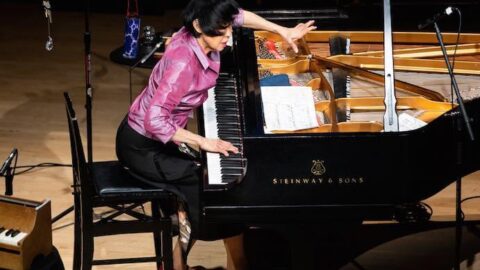On Thursday, April 26, 2018 at Merkin Hall, Margaret Leng Tan performed a program entitled “Cage, Crumb, and Beyond—Celebrating the Avant-Garde Piano” as the final concert of this season’s Ecstatic Music Festival, co-presented by New Sounds Live. Most notably, this concert featured the New York premiere of George Crumb’s Metamorphoses (Book I) (2015-17), his first major work for the piano since the Makrokosmos series forty years prior.
The composers featured on the evening’s gargantuan program were united by their interest in expanding the timbral potential of the piano. These pieces included elements such as extended techniques (alternative techniques for playing the piano such as directly on the strings, or on the keys with forearms and fists), prepared piano (in which objects are inserted between and onto the strings of the instrument to alter its timbre), and the use of auxiliary instruments, such as small percussion, toy piano, and voice.
The first half of the program included works by John Cage and Toby Twining, as well as world premieres by Suzanne Farrin and Kelly Moran. Tan opened with Cage’s prepared piano classic The Perilous Night (1944). To prepare the piano, materials had been inserted between the strings—in this case, bolts, screws, felt, rubber, and bamboo. The resulting timbres were sometimes metallic and gamelan-like, sometimes woody and hollow, and were coupled with tweaky rhythms and circular, grooving variations on motivic material. This piece inspired a 1990 painting by Jasper Johns (of the same title), which in turn was the inspiration for the sixth movement of Crumb’s Metamorphoses (Book I), performed on the second half.

In Farrin’s Sacred Monster (2018), Tan used a hairbrush to summon delicate and fuzzy textures from the tuning pegs of the piano. Later, she dragged a wooden spatula across the keys to create dynamic clicking and clacking sounds. There is a certain charm to reimagining such pedestrian items in a musical context, and Tan’s discipline and care with this work revealed its subtleties.
Toby Twining’s Satie Blues (1995) paired a blues progression on the grand piano with soloistic writing for the toy piano. The slightly out-of-tune sound of the toy piano was a charming compliment to the full-bodied harmonies on the Steinway, and Tan’s richly expressive performance breathed life into the instrument. Kelly Moran’s Helix II (2018) for piano and toy piano, also a world premiere, wrapped up the first half of the program. The opening movement was chock full of metallic sounding arpeggiated material pressed between expansive low tones and piercing interjections on the toy piano. The third movement offered fiery, luscious writing that was at the same time distorted and alien, as if transmitted from a distant planet.
The second half of the program featured the much-anticipated New York premiere of George Crumb’s Metamorphoses (Book I) (2015-17). Loosely structured after Mussorgsky’s nineteenth century keyboard masterpiece Pictures at an Exhibition (1874), the ten movements of Metamorphoses (Book I) draw inspiration from the paintings of artists such as Paul Klee, Salvador Dali, and Vasily Kandinsky, among others.

In some ways, Metamorphoses (Book I) feels like a continuation of the Makrokosmos series rather than an entirely separate work. Many of the same textures, techniques, and timbres that are found in the first two books of Makrokosmos (such as the low, resonant muted tones, and scraped and strummed strings of the first movement “Black Prince (1927) – Paul Klee”), are woven into these pieces. But far from a stale rehash of prior work, Metamorphoses (Book I) has a freshness about it that comes out in surprising and wonderful ways, most often through drawing upon Tan’s brilliant attention to performance elements that extend past the big piano.
In the seventh movement, “Clowns At Night (1957) – Marc Chagall,” Tan donned a red clown nose as she played haunting passages on the toy piano, jingled a wind chime, and captured the spirit of the clown with her voice as she laughed and moaned in equally unsettling and enchanting ways. In the third movement, “Wheatfield With Crows (1890) – Vincent van Gogh,” Tan took on the curious persona of the crow as she tapped and rattled the instrument, occasionally emitting a sorrowful “caw.”

Crumb’s more conventionally idiomatic and virtuosic writing for the instrument is also found in movements such as “Perilous Night (1990) – Jasper Johns.” Exciting and terrifying, the relentless and zippy material on the keys is punctuated by extended techniques played inside the instrument, and the sizzle of a metal chain draped across the lowest strings. The final movement, “The Blue Rider (1903) –Vasily Kandinsky,” is an athletic showpiece that weaves together folky thematic material with rousing rhythmic drive.
In traversing this epic work, Tan never lost sight of the details; every moment was presented with keen intensity and profound intimacy, qualities that made each movement shine brilliantly like polished stones. Rising from the bench like a climber who just summited a large mountain, she received a well-deserved standing ovation and a storm of applause.
























